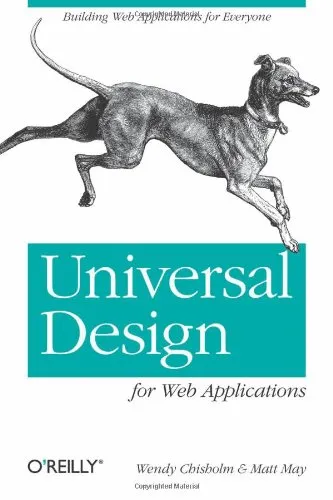Universal Design for Web Applications: Web Applications That Reach Everyone
4.5
Reviews from our users

You Can Ask your questions from this book's AI after Login
Each download or ask from book AI costs 2 points. To earn more free points, please visit the Points Guide Page and complete some valuable actions.Introduction to "Universal Design for Web Applications: Web Applications That Reach Everyone"
"Universal Design for Web Applications: Web Applications That Reach Everyone" is a pivotal guide for those who design and develop digital experiences. Authored by Wendy Chisholm and Matt May, this book delves deep into the principles of universal design and accessibility, providing invaluable resources for making the web more inclusive and effective for everyone. In an increasingly digital world, ensuring web accessibility is paramount—not just as a legal or ethical responsibility but as a fundamental cornerstone for building robust, user-friendly web applications.
This book addresses the technical, social, and practical aspects of web accessibility, giving readers the tools and techniques they need to ensure their applications comply with the latest standards and accommodate as many users as possible. Whether you’re a developer, designer, project manager, or stakeholder, this book will help you create better web applications by integrating accessibility into every stage of your development process.
Detailed Summary of the Book
The book is structured to take readers on a thoughtful journey, starting with the fundamentals of universal design and accessibility. It introduces key concepts such as the principles of inclusive design and how they influence the experience of diverse users, including those with disabilities, older adults, and individuals using alternative devices or networks. The authors emphasize that access to web content is not just a technical challenge but a human rights issue, highlighting the importance of providing equitable opportunities for all users.
Wendy Chisholm and Matt May discuss guidelines, laws, and standards like the Web Content Accessibility Guidelines (WCAG) and Section 508, offering real-world case studies that illustrate the need for accessible design. The book also explores how to incorporate accessibility throughout the development lifecycle—from planning and prototyping to coding, testing, and deployment—ensuring your design decisions are inclusive from the start.
Readers will find practical advice on various accessibility techniques. For example, the authors explain how to create semantic and navigable HTML, use ARIA (Accessible Rich Internet Applications) to improve modern web interactions, and optimize content for assistive technologies such as screen readers. Usability is a recurring theme, as the book highlights how accessible designs improve the overall user experience for everyone, not just individuals with disabilities.
The book concludes with forward-looking thoughts about the evolving landscape of web accessibility, urging readers to approach accessibility as a journey rather than a destination. It inspires readers to think beyond compliance, fostering a mindset of innovation and empathy.
Key Takeaways
- Understanding the principles of universal design to make web applications usable for the widest audience possible.
- Practical tips on implementing accessibility features, such as semantic HTML, ARIA, and adaptive designs.
- Insight into accessibility laws and standards like WCAG and how they apply to real-world projects.
- Strategies for integrating accessibility into the development workflow from start to finish.
- Examples of how accessible design improves usability and user satisfaction for all audiences.
Famous Quotes from the Book
"Accessibility is not a feature; it is a social good that benefits everyone."
"Designing for accessibility isn't about limiting the experience; it's about expanding it to include all possible users."
"Good design is accessible design—it aligns with best practices, enhances usability, and fosters inclusion."
Why This Book Matters
In a world where digital experiences are essential to daily life, creating inclusive web applications is no longer optional; it's a necessity. This book matters because it equips readers with the knowledge to bridge the accessibility gap and design systems that work for everyone, regardless of their abilities or circumstances. It shifts the focus from compliance to empathy, inspiring professionals to think critically about how their decisions influence the lives of diverse users.
Moreover, with the global move toward digital transformation, the principles outlined in "Universal Design for Web Applications" are more relevant than ever. Accessible and user-friendly web design not only ensures compliance with legal standards but also broadens market reach, improves brand reputation, and fosters a more equitable world.
Ultimately, this book is a call to action. By putting the principles of universal design into practice, professionals across industries can create a more inclusive web that empowers everyone to participate fully in the digital age.
Free Direct Download
You Can Download this book after Login
Accessing books through legal platforms and public libraries not only supports the rights of authors and publishers but also contributes to the sustainability of reading culture. Before downloading, please take a moment to consider these options.
Find this book on other platforms:
WorldCat helps you find books in libraries worldwide.
See ratings, reviews, and discussions on Goodreads.
Find and buy rare or used books on AbeBooks.


